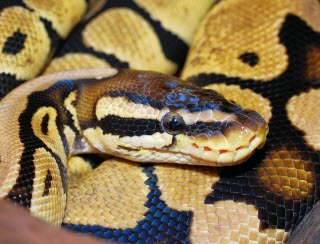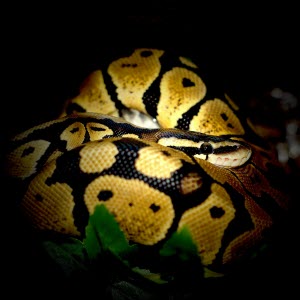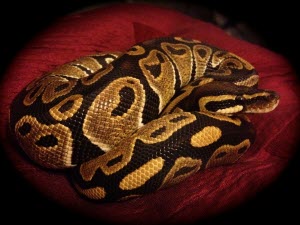
Ball Pythons are awesome snakes that are a great pet. They are smaller than most of the rest of the pythons and boas, only growing to about 3 feet in length. Though there are a number of snakes that stay relatively short, Ball Pythons are popular because they are a robust, large bodied snake. In addition, they have a very mellow, laid back attitude and are rare to bite (unless they miss striking at their food). If you are considering adopting a snake, a Ball Python is a good first snake species to have.
When we see reptiles here at AEC for emergency care, a majority of the cases are related to suboptimal husbandry and care. Well meaning people that believe they are keeping their snake properly may begin to see illnesses related to inappropriate temperature, humidity, diet, and overall husbandry. Snakes can be one of the easier reptile species to keep in captivity if you learn how to care for them, but when you fail to provide proper husbandry, your snake can suffer from serious health issues.
When deciding to get a snake, make sure you get an appropriate cage. Your snake should be kept in an enclosure 1.5 times its length. Considering your snake can live 20-30 years, planning ahead is not a bad idea. Of course, you can start with a smaller cage and upgrade as your snake grows. An aquarium with a wire secure lid or a slide front enclosure is recommended as they are generally relatively escape proof when properly secured. Snakes are strong and good at finding flaws in your security! In addition, if they believe there is a chance of escape, they will injure their nose trying to push their way out.

Snakes are ectothermic. This means they do not produce their own body heat like mammals. Instead they must find warm areas in the environment to bring their body temperature up to a level for proper metabolism. Keeping your snake at the proper temperature is important. An ambient temperature of 75-78 F in a majority of the enclosure, with a basking spot at 85-90F will keep a ball python happy. You will want to have a couple small thermometers to place in the enclosure to monitor these temperatures. For the most accurate readings thermometers should be placed where the snake is, not on the side of the tank. To maintain these increased temperatures you can add an under-tank heater to one end of the enclosure and a red basking light (usually 50W-100W depending on tank height). Using a red spot basking light allows you to leave the light on at all times without worrying about light cycles.
Ball pythons like a humidity level of about 70-80%. To attain this, include a large water bowl (or even a small cat litter box) in your enclosure. This is large enough for the snake to soak in, and if placed under the basking spot, will be warm and help increase the humidity of the enclosure. Your enclosure should include a small, inexpensive hydrometer to monitor humidity.
When setting up your enclosure, there are a few additional things to consider. First is substrate - the bedding you use can be an issue. Although there are loose fiber beddings that can be used (wood chips, bark, etc.) the easiest substrate to clean, and a low cost product that also eliminates the worry of the snake ingesting substrate (and becoming impacted) is artificial turf (indoor/outdoor carpet). Purchase at least 2 pieces that fit your cage, then you can remove and replace as it becomes soiled. This type of carpet can be washed and reused for quite a while. It is best to hem the edges or otherwise make sure there is no fraying on the edges to avoid your snake getting tangles.
Inside the cage, your snake wants an interesting and functional environment. They will need 2 hides (which can simply be upside down opaque plastic containers with a door cut out). One hide should be in a warm spot in the tank, and the other should be in a cool spot. Your snake will want to feel safe and hide a good portion of the day. If they only have a hide in the cooler part of the cage, they will spend more time in that area and will not be able to maintain body temperature. Adding branches for climbing and other things for the snake to climb over adds interest to the environment as well.
It is highly recommended not to feed live prey to your pet snake. Live prey can injure the snake severely. Feeding thawed frozen food generally works very well - it is cheaper, safer, and generally easier. The key to feeding thawed frozen mice is bringing them up to proper temperature. To do this, place the mouse in a hot water bath. Once thawed, change into fresh hot water to make sure you are getting the mouse to approximately 100F. NEVER microwave a mouse since hot spots will develop inside it and can injure your snake.

With proper care, a ball python can be a great member of your family and live a long healthy life. If you are considering getting a ball python, please consider checking out the local rescues and saving a life instead of purchasing. But first and foremost, you need to be prepared for the commitment of up to 30 years of care, and you need to become well educated about the species before getting any snake!
Edi Sonntag, MS, Veterinary Technician
